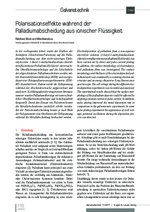
Polarisationseffekte während der Palladiumabscheidung aus ionischer Flüssigkeit
Artikelnummer: GALVANO-16443
Downloadbares Produkt
Polarisationseffekte während der Palladi
In der vorliegenden Arbeit wurde der Einfluss der Stromform (Gleichstrom/Pulsstrom) auf die Palladiumabscheidung aus dem nicht-wässrigen Elektrolytsystem 1-Butyl-3-methylimidazolium-chlorid-tetrafluoroborat/Palladium(II)chlorid untersucht. Die Oberflächenmorphologie und die Schichtdicke der abgeschiedenen Palladiumschichten wurden mittels Rasterelektronenmikroskop (REM) und energie- dispersiver Röntgenfluoreszenzspektrometrie (EDX- RF) charakterisiert. Zudem wurde die Zellspannung während der Abscheideversuche aufgezeichnet und analysiert. In Abhängigkeit der eingesetzten Stromparameter wurden Palladiumüberzüge mit unterschiedlicher Oberflächenmorphologie und Schichtqualität hergestellt. Durch den Einsatz von Pulsstrom konnte die Metallabscheiderate zusätzlich erhöht werden. Bei der Pulsstromabscheidung konnte je nach Wahl der Pulsparameter eine Oszillation der Zellspannung während der Metallabscheidung beobachtet werden. //Electrodeposition of palladium from a non-aqueous electrolyte solution (1-butyl-3-methylimidazolium- chloride-tetrafluoroborate/palladium(II)chloride) has been carried out by direct and pulse current plating. In addition, the surface morphology of electrodeposited palladium films was investigated. The surface morphology and thickness of the electrodeposited pal- ladium layers was examined by a scanning electron mi- croscope and an energy dispersive X-ray fluorescence spectroscope. The cell voltage during the different elec- trodeposition experiments was recorded and analysed. The experimental results showed that the surface mor- phology of the palladium deposits could be effected by applying constant current or pulse current. In addition, pulse plating improved the metal deposition rate in comparison to the galvanostatic experiments. In some pulse plating experiments the appearance of (cell voltage) potential oscillations during the deposition pro- cess was detected.
2,70 €
Netto-Preis: 2,52 €
Enthaltene MwSt.: 0,18 €